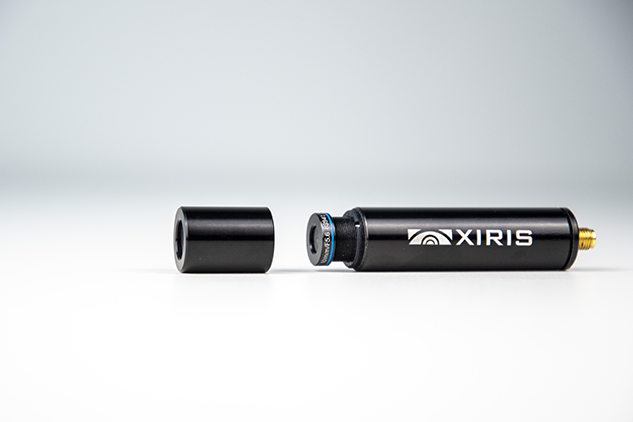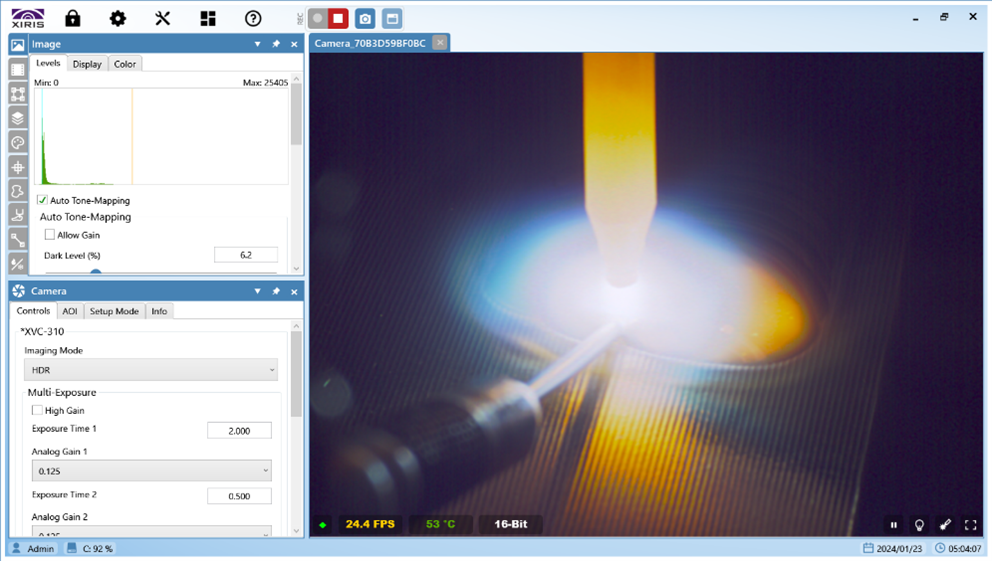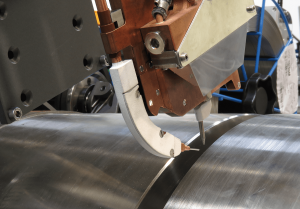Narrow gap welding is a joining process that is most often used to weld thick sections of material economically. It requires preparation of the joint with steep angles designed to require less weld metal and less welding time to fill the joint which is usually no more than about 25 mm (1”) in width.
Tungsten Inert Gas Welding (TIG or GTAW) is often used as the welding method of choice for many narrow gap welding applications such as pipe welding, pressure vessel construction and other critical fabrications and is often integrated into weld automation equipment such as in orbital welding or linear tractor welding systems.
Because of the depth of the gap (which can be up to 300 mm), it is essential to be able to monitor the progress of the weld to verify the integrity of the weld process. Some welding defects, such as lack of sidewall fusion, are a common problem in narrow gap welding, requiring a constant, good quality view of the welding process to properly monitor it.
|
Fig. 1: Narrow Groove Welding (courtesy Polysoude, www.polysoude.com) |
Why Add a Camera to the Narrow Gap Welding Process?
-
Look for sidewall fusion – often caused by incorrect welding parameter settings or poor surface preparation, this is a random event that needs constant monitoring to be seen.
-
Look for Interpass fusion – when one pass is deposited on top of a previous pass, incorrect welding parameters or cleanliness issues can also cause fusion issues between passes, and other random events that requires constant monitoring.
-
Ensure alignment of arc to sidewall – Even the best equipment can wander over time, causing better coverage and fusion on one side of the weld than the other.
-
Ensure any machine oscillation of the weld torch is symmetric – Oscillation is a great way to improve the sidewall fusion on both sides of the weld, but it needs to be constantly monitored to ensure that both sides are getting sufficient dwell time for fusion to occur.
Weld cameras have been used to help monitor narrow gap welding processes for many years. Because of the small size of the narrow gap channel, cameras must compete for limited space with all the typical equipment in the area of the weld: one or two weld torches, wire feeders and even pre-heaters.
The presence of all this equipment requires that any camera added to the mix must be very small.
Historically this was addressed using a category of cameras known as “lipstick” or “bullet” cameras – small cameras of about 17 mm in diameter, typically colour, that were small enough to see down into the gap of the narrow groove seam.
The early cameras were all analog and did not offer HDR (High Dynamic Range) imaging which meant that the welding arc was often saturated. Because there was nothing better, this usually met the industry’s needs until the cameras were no longer being manufactured. In recent years, many fabricators have struggled to run their narrow gap welding equipment as their legacy lipstick weld cameras have been slowly dying with no suitable replacement on the market.
Recognizing this issue, Xiris developed the XVC-310 lipstick camera. With many years’ experience developing High Dynamic Range (HDR) cameras suitable for welding, Xiris worked to develop a small format all-digital color camera that can serve as a drop-in replacement for legacy narrow gap welding cameras.

Fig 2: The Xiris XVC-310 Lipstick HDR Weld Camera (Xiris) |
The XVC-310 has HDR imaging capability that generates high contrast images (>120 dB) of the welding process to allow operators to remotely view and monitor welding processes where access to the joint is restricted. The HDR imaging capability allows for the display of the weld arc and its darker surrounding environment all in the same image.
The digital video information that is generated can be sent to a PC for display, recording and playback. Partnered with Xiris’ machine vision software, features such as the TIG tip, melt pool, weld bead, weld seam, parent material and wire feeding can be automatically inspected before, during and after welding.
The XVC-310 represents the next generation of camera for Narrow Gap Welding Processes with a few key advantages:
- Compact Design: At 17 mm diameter, the Camera Head mirrors the dimensions of most legacy Lipstick cameras, ensuring seamless integration into tight spaces.
- HDR enhanced Color Imaging: With more than 120 dB of HDR capability, the XVC-310 delivers outstanding images, providing a clear and detailed view of critical features within and around the melt pool and welding process. The color and appearance of those feature can provide valuable information about the welding process and base material.
- Industry 4.0 Connectivity: The system is easily connected via a Camera Controller to Xiris Software through GigE ethernet, with the ability to build next-level automation via machine vision functionality in Xiris’ WeldStudio Pro software suite.

Fig. 3: Images from the XVC-310 Weld Camera in WeldStudio Pro |
\
Where to Put a Weld Camera in a Narrow Gap Welding Process?
There are really two choices as to where a camera should be placed to monitor a Narrow Gap welding process: in front of the torch looking back at the process (Leading View) and behind the torch looking forward to the process (Trailing View). Both views can provide different sorts of information:
Leading View – provides a good image of the leading edge of the melt pool, the seam-to-torch alignment, the condition of the torch tip and the quality of the sidewall or interpass fusion.
Trailing View - provides a good image of the shape and location of the solidifying weld bead, the wire feed speed, wire tip location and droplet formation, surface defects such as slag, porosity or silicates.
Fig. 4: The Narrow Gap Welding Process with Flanges to mount Camera for Leading or Trailing Views |
Summary
Narrow Gap Welding is an important process to control properly to ensure critical welds are made correctly. For this to happen, cameras to monitor the process are an essential component of any narrow gap welding system. Legacy cameras that have been used over the years are no longer available or obsolete.
The new XVC-310 lipstick weld camera from Xiris is a drop-in replacement for most of the legacy cameras due to its compact size and provides the next generation of capability as an all digital camera that can deliver images for weld monitoring and inspection.
Stay up to date by following us on social media or subscribe to our blog!





.png)


